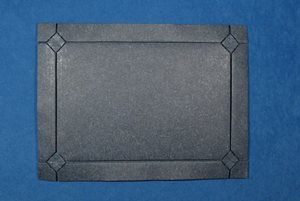Hydrangea Picture Frame


This picture frame can hold a standard 15×10 cm photograph. It consists of four molecules of the Hydrangea Tessellation (designed by Shuzo Fujimoto), spaced apart in such way that a picture can be inserted into the space between them.
My sister-in-law Bogna gave me the idea of making a photo frame when I showed her the standard low-density Hydrangea tess.
The picture is held in place only at its corners by the petals on the inner edge of the frame. The picture’s edges are not covered by the frame at all, so almost all the area of the image is visible. Despite such small tabs, the picture sits inside the frame quite securely.
The size of the hydrangea flowers and the thickness of the frame relative to the size of the area used for the picture can be made arbitrarily large or small. This requires a bit of calculation to lay out the paper well (tip: the picture’s edge lies at 13/16 of the width of the Hydrangea molecule). Precise folding is required, especially if you want to make the frame narrow relative to picture size.
If you fold the frame a little bit too small and the picture bulges when you try to insert it, you can pierce the paper edge which is hidden under the petals on the inner edge of the frame with a knife. The picture’s corners will then be able to go through the slits instead of being pressed against the paper so that a larger picture can fit in.
I later found the same idea independently developed by others (for example here). Many folders do not adapt the proportions of the hydrangeas relative to the free space available for the picture, though.
Comments